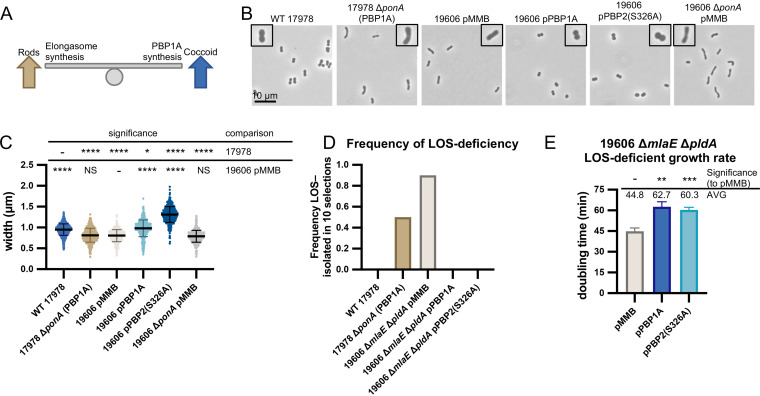FIG 6.
High PBP1A levels inhibit the elongasome which is toxic to LOS-deficient A. baumannii. (A) Observed balance between elongasome and PBP1A peptidoglycan synthesis and effects on cell shape. High elongasome synthesis results in longer rod-shaped cells, while high PBP1A synthesis results in shorter and coccoid cells. (B and C) Phase-contrast microscopy and cell measurements of 17978 and 19606 strains with changes in PBP1A protein levels. Overexpression of PBP1A and dominant-negative elongasome subunit PBP2(S326A) resulted in the same coccoid phenotype, suggesting high PBP1A levels inhibit the elongasome (25 μM IPTG). Microscopy imaged at ×100 magnification and all field of views were resized identically with a 10-μm scale bar on the first image of each panel. A single cell from the field of view is highlighted with a 2× magnified inset. Cell measurements were performed on ≥400 cells with MicrobeJ and assessed for significant differences as indicated in the Materials and Methods. (D) High PBP1A expression levels that caused coccoid morphology correlated with an inability to isolate LOS-deficient mutants. Shows the frequency of LOS-deficient mutants out of 10 replicate selections. (E) Inhibition of the elongasome when PBP1A or PBP2(S326A) were overexpressed in a stable 19606 ΔmlaE ΔpldA LOS-deficient strain resulted in severe growth defects. Above, average doubling times and significant differences, assessed from triplicate cultures as described in the Materials and Methods. NS indicates not significant; *, P ≤ 0.05; **, P ≤ 0.01; ***, P ≤ 0.001; ****, P ≤ 0.0001.

